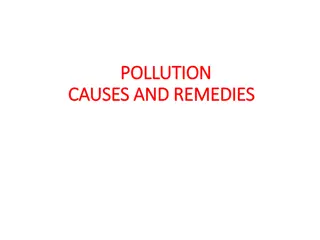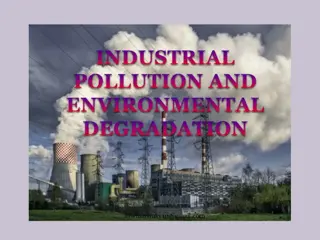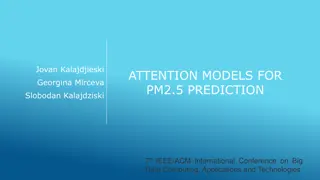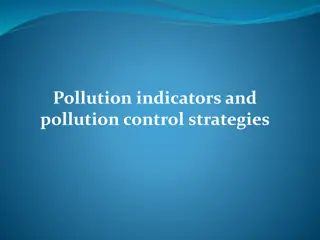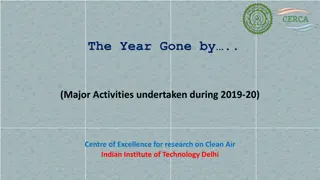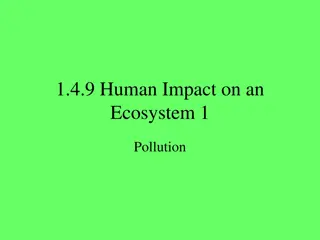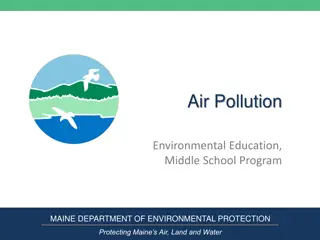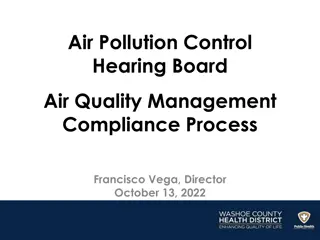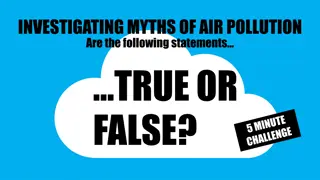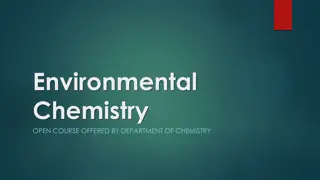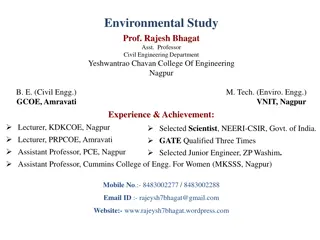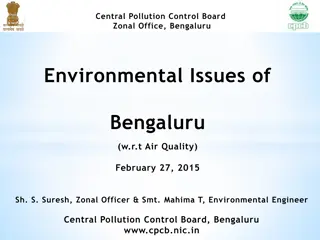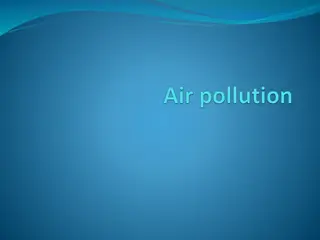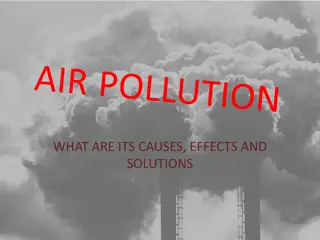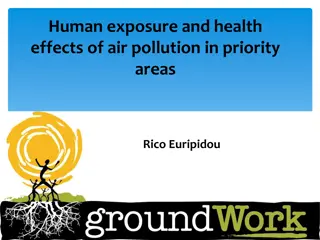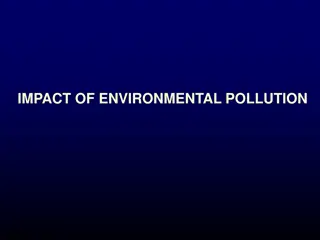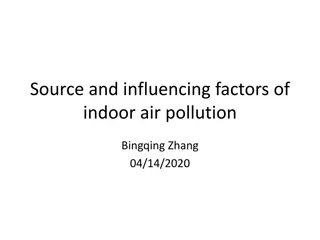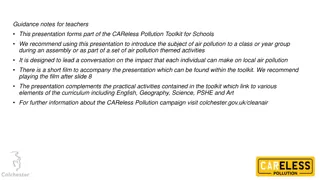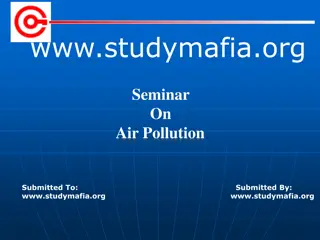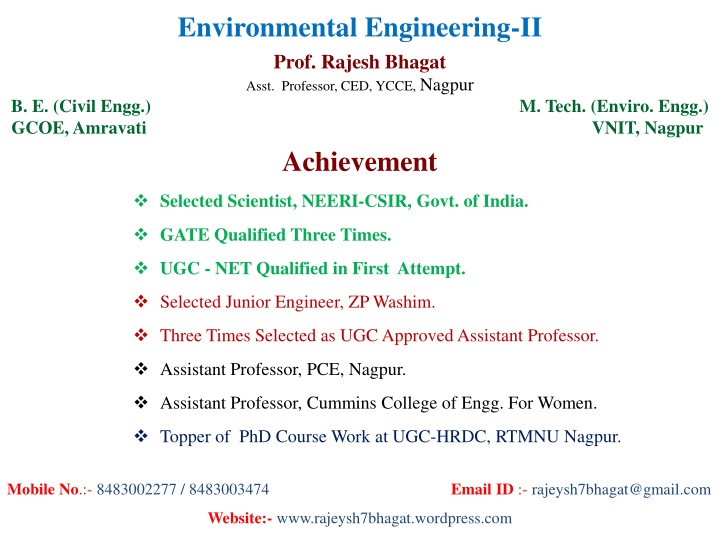
Air Pollution and Its Impact on the Environment
Explore the world of air pollution through the eyes of Environmental Engineering II Professor Rajesh Bhagat. Learn about the importance of studying air pollution, its different forms, and how it affects both humans and the environment. Discover the causes of air pollution, its monitoring methods, and techniques for control. Gain insights into the alarming repercussions of pollution on air quality, water, soil, and living organisms.
Uploaded on | 4 Views
Download Presentation

Please find below an Image/Link to download the presentation.
The content on the website is provided AS IS for your information and personal use only. It may not be sold, licensed, or shared on other websites without obtaining consent from the author. If you encounter any issues during the download, it is possible that the publisher has removed the file from their server.
You are allowed to download the files provided on this website for personal or commercial use, subject to the condition that they are used lawfully. All files are the property of their respective owners.
The content on the website is provided AS IS for your information and personal use only. It may not be sold, licensed, or shared on other websites without obtaining consent from the author.
E N D
Presentation Transcript
Environmental Engineering-II Prof. Rajesh Bhagat Asst. Professor, CED, YCCE, Nagpur Achievement B. E. (Civil Engg.) GCOE, Amravati M. Tech. (Enviro. Engg.) VNIT, Nagpur Selected Scientist, NEERI-CSIR, Govt. of India. GATE Qualified Three Times. UGC - NET Qualified in First Attempt. Selected Junior Engineer, ZP Washim. Three Times Selected as UGC Approved Assistant Professor. Assistant Professor, PCE, Nagpur. Assistant Professor, Cummins College of Engg. For Women. Topper of PhD Course Work at UGC-HRDC, RTMNU Nagpur. Mobile No.:- 8483002277 / 8483003474 Email ID :- rajeysh7bhagat@gmail.com Website:- www.rajeysh7bhagat.wordpress.com
UNIT-VI 1) Introduction to Air Pollution, 2) Meteorological Parameters. 3) Monitoring Methods. 4) Techniques of Air Pollution Control.
What is Environment ? Natural world Surrounding in which we live Life sustaining system in which various living and non-living things are inter-related Collection of all the external factors or conditions influencing the life of the organisms 3
Why it is important to study air pollution:- Man can Survive for 5 weeks without food, For 5 days without water, But cant survive 5 minutes without air Man consumes 2 liters water per day Man breaths on an avg. 25000 times a day at a rate of 1-2 liters per breath It means requires enormous quantity of air for his survival and it goes into direct contact with the most sensitive organs of the human body. In water Conc. Of lead More than 300000ug/m3 is harmful. In air conc. Of lead more than 1.5ug/m3 is harmful. Once it is discharged in the atmosphere then it is impossible to control. Air pollutants can transfer from one point to other and can give adverse effect .. 4
Pollution is defined as the excessive discharge of undesirable substances into the environment, adversely altering the natural quality of the environment and causing damage to humans, plants and animals. 1) Water Pollution 2) Soil Pollution 3) Air Pollution 5
What is Air Pollution ? Perception (When did you last say Hey, that is air pollution ?) Visible (smoke, dust, chimney smoke) (Grey Scale) Odour (petrol, diesel, H2S, bleaching powder) 6
How will you define Air Pollution? 1) Air pollution is the presence of one or more contaminants in the ambient atmosphere which is injurious to living and non-living things or which unreasonably interfere with the comfortable enjoyment of life and property. 2) Air pollution is the presence of foreign matter in the air either gaseous or particulate or combination of both which is dangerous to the health and welfare of human beings. 3) Air pollution is the excessive concentration of foreign matter in the air which adversely affects the human-being or living things or causes damages to property. 4) Air pollution is the presence of substances in air in sufficient concentration and for sufficient time, so as to be, or threaten to be injurious to human, plant or animal life, or to property, or which reasonably interferes with the comfortable enjoyment of life and 8 property. Air pollutants arise from both manmade and natural processes.
What is clean air ? :- 78.1% Nitrogen + 20.9% Oxygen + 1% Trace 9
Air pollutant:- A substance in the air that can cause harm to humans and the environment is known as an air pollutant. The ambient air quality may be defined by the concentration of a set of pollutants which may be present in the ambient air we breath in. These pollutants may be called criteria pollutants. Ambient air quality refers to the quality of outdoor air in our surrounding environment. It is typically measured near ground level, away from direct sources of pollution. Emission standards express the allowable concentrations of a contaminant at the point of discharge before any mixing with the surrounding air. Emission standards are legal requirements governing air pollutants released into the atmosphere. Emission standards set quantitative limits on the permissible amount of specific air pollutants that may be released from specific sources over specific timeframes. 15
Types of Air Pollutants: Primary Air Pollutant: Harmful substance that is emitted directly into the atmosphere. Ex. Natural Contaminants, Particulate Matter (PM), Sulfur dioxide, Oxides of Nitrogen, Carbon Monoxide, Carbon Dioxide, Hydrogen Sulfide, Hydrogen Fluoride, Hydrocarbons, Volatile Organic Compounds (VOC), Toxic Metals, such as lead, cadmium and copper, Chlorofluorocarbons (CFCs), Ammonia (NH3), Odors, Noise, etc. Secondary Air Pollutant: These are not emitted directly but formed in the atmosphere when a primary air pollutant reacts with substances normally found in the atmosphere or with other air pollutants. Examples are ground level Ozone, Smog (Photochemical Smog), Peroxy- Acytyl Nitrate (PAN), Formaldehyde, Acid Mist, etc. Some pollutants may be both primary and secondary: that is, they are both emitted directly and formed from other primary pollutants. 16
18 Table 6.1 Air Pollutants (16)
Major Classes of Air Pollutants: 1) Particulate Material (Dust, Fog, Mist, Fumes) 2) Oxides of Nitrogen ( NO, NO2, NO3) 3) Oxides of Sulphur ( SO2, SO3, etc) 4) Oxygen compound (CO, CO2, O3) 5) Hydrocarbons (VOC, CH4, Non CH4)
Air Pollutants:- 1) Natural Contaminants:- Ex. Natural Fog, Pollen grains, bacteria, and product of volcanic eruption. Pollen is important because of its peculiar properties irritating to some individuals. It discharged into atmosphere from plant, vegetation, weeds, trees grass, etc. Many people suffers from asthama or hey fever & bronchitis.
2)Aerosols (Particulate Matter):- (200 ug/m3) Ex. Dust, Smoke, Mist, Fog, & Fumes. Solid or liquid particle of microscopic size suspended and dispersed in a gas or atmosphere. They range from 0.01 to 500 u. Aerosol also defined as a colloidal system in which the dispersion medium is a gas and the dispersed phase is a solid or liquid. They differs widely in terms of particle size, particle density and their importance as pollutants. PM10 & PM2.5
Dust:- Small solid particle generated by crushing, grinding, blasting of material. range from 1u to 200u. Can settle under gravity. Ex. Fly Ash, Cement, Foundry dust, etc
Smoke:- Aerosol particle resulting from incomplete combustion. size less than 1u.
Fog:- Liquid particle formed by condensation of vapour. Visible aerosol Dispersed phase is liquid Reduces visibility less than 0.5 km Size range from 1u to 40u.
Mist:- Liquid particle formed by condensation of vapour. Water droplet in air of size 40u to 500u Visibility upto 1km or more Low concentration of dispersion of liquid particle of large size.
Fumes:- Very fine solid particle. Size 0.001 to 1u. Unpleasant smelling airborne effluent. Generated by condensation from the gaseous state and often accompanied by a chemical reaction such as oxidation.
3) Gases:- Ex. Sulphur Dioxide, Oxide of Nitrogen, Hydrogen sulphide, Carbon Monoxide, Carbon Dioxide, Hydrogen Fluoride, Hydrogen Chloride, Hydrocarbons, Aldehydes, Radio active gases, CFC, etc.
Sulphur Dioxide:- 80ug/m3 1) Principal constituents of air pollutants. 2) Combustion of fuel specially coal. 3) Sulphur content of fuel. 4) Crude petroleum product contain1% to 5% of sulphur content. 5) Fuel gases contain sulphur but small quantity. 6) Another source is metallurgical operations. 7) Many ores like zinc, copper, lead are primarily sulphides. 8) Sulphuric acid plant. 9) Paper manufacturing plant. 10)Incinerator.
Oxides of Nitrogen:- 80ug/m3 1) 2nd most abundant atmospheric contaminants. 2) Highest conc. Of NOx in effluent from industry where nitric acid is used. 3) Next highest conc. is in automobile exhaust. 4) Large power plant, low heat burners, furnace etc. also contribute. 5) High temp. processes.
Carbon Monoxides:- 2000ug/m3 (0.03%) 1) Odourless & colourless gas. 2) Dangerous gaseous pollutant. 3) Produced from incomplete combustion of carbonaceous matter. 4) Chief source is automobile exhaust. 5) Loss of consciousness, concentration, headache, retardation of mental activity, weakness, etc 6) Reacts with haemoglobin of blood to give carboxy haemoglobin.
Hydrogen Sulphide:- 2ug/m3 (Rotten egg emits.) highly toxic, flammable & Foul smelling gas. Anaerobic biological decay processes. Volcanoes & water springs. Kraft pulp industry, petroleum refineries, coke-oven plants & chemical processes.
Carbon Dioxide:- CO2 1) Occurs naturally in the atmosphere. 2) Essential ingredient in photosynthesis, the process by which plants make food and energy, 3) Released due to respiration by animal & plant. 4) Deforestation and the burning of fossil fuels such as coal Eruption of volcanoes, forest fires, biological decay, etc. 5) Green house gas increase mean ambient temp & mean sea level.
Hydrogen Fluoride:- HF 1) Major- Manufacturer of phosphate fertilizer, aluminum industry, brick plants, etc. 2) Minor - Other metallurgical operations & burning of coal. 3) More important in terms of injury to vegetation & animal than human. Hydrogen Chloride:- HCl 1) Industrial Chemical processes. 2) Effects on respiratory irritation from chlorine. 3) Damage to vegetation. 4) Corrosion. Chloro Fluro Carbon:- CFC 1) Non-toxic, non-flammable & non-carcinogenic. 2) But harmful or damages to ozone layer allows UV rays to reach the earth surface. 3) A.C., Refrigerator, Sprays, etc.
Aldehydes:- 1) Combustion of gasoline, diesel, oil, fuel, & natural gas. 2) Incomplete oxidation of motor fuel & lubricating oils. 3) Irritates to eyes. Radioactive Gases:- 1) Nuclear power reactor & related fuel handling facilities. 2) Experimental accelerator, testing of nuclear bombs, agricultural, industrial , medical use of radioactive isotopes.
Ozone:-O3 1) In the earth s upper atmosphere ozone plays imp. role by providing a shield from UV rays but Ozone at GL is harmful air pollutant. 2) Not emitted directly in the air but it is created by chemical reaction between NOx & VOC in presence of sunlight. 3O2( + NO2 catalyst & Sunlight) 3) Breathing Ozone trigger health problems like asthama, chest pain, coughing, throat ==> 2O3 irritation & congestion. 4) Reduces lung function & inflame the lining of lungs. 36
Smog:- 1) Combination of smoke & fog. 2) Photochemical & Coal Induced smog. 3) Restricted & highly motorized area in metro cities. 4) Occurs under adverse meteorological condition when air movement is restricted. 5) Reduces visibility, causes eye irritation, damages to vegetation & cracking of rubber. 6) Prolonged exposure may result high mortality rate.
39 Fig. 6.2 Air Pollutant Sources (16) 39
Acid Mist / Acid Rain:- Acid mist or acid rain is any other form of precipitation that is unusually acidic, meaning that it possesses elevated levels of hydrogen ions (low pH). It can have harmful effects on plants, aquatic animals and infrastructure.
PAN ( Peroxy Acytyl Nitrate):- Produced from the combination of hydrocarbons, and nitrogen dioxide in the presence of sunlight and heat. Hydrocarbons + O2 + NO2+ light CH3COOONO2 (PAN) The general equation is CxHyO3 + NO2 CxHyO3NO2 Cause eye irritation, damages to plant, skin cancer, etc.
Formaldehyde:- 1) It is organic chemical prevalent in environment. 2) Colourless gas with pungent odour from family of gases aldehyde. 3) It is formed by numerous natural sources & anthropogenic activities. 4) Released from through biomass combustion / forest fires, decomposition & through volcanoes. 5) Power plant, incineration, automobile exhaust, etc. 6) Cause cancer. 7) Irritation to respiratory tract. 42
Effects of Air Pollution on Human Health:- Man easily affected by air pollution. Inhalation of air pollutants through respiratory system gives direct impact on human health. Factors affecting impact of air pollutants on man are :- Type of air pollutant. Concentration of air Pollutant. Duration of exposure of air pollutant. Health condition of the receptor. Age group of the receptor. 43
Effects of Air Pollution on Human Health:- 1) Cause irritation to the eye. 2) Cause nose & throat irritation. 3) SO2 & PM: Irritate respiratory tract and causes damages to lungs. 4) NO2: Causes airway restriction 5) CO: reduces oxygen carrying capacity of blood, Causes headache, fatigue, drowsiness, death. 6) CO increase stress on those suffering from cardio-vascullar & pulmonary disease. 7) Ozone: Causes burning eyes, coughing, and chest discomfort 8) Gases like H2S, amonia, etc. cause odour nuisance. 9) Increases mortality rate & morbidity rate. 10)Pollen initiate asthamatic attack. 11)Chronic pulmonary disease like bronchitis & asthama are aggravated by SO2, NO2, PM, Smog, etc. 44
Effects of Air Pollution on Human Health:- 1) HF cause diseases of the bone (fluorosis) & molting of teeth. 2) Carcinogenic agents causes cancer. 3) PM (Dust) cause respiratory disease like silicosis, asbestosis, etc. 4) Heavy metals like lead cause poisoning. 5) Retardation of mental activity. 6) Loss of concentration, weakness, etc. 7) Cause skin cancer. 45
Effects of Air Pollution 48 Table 6.2 Air Pollutant Effects (16)
Effects of Air Pollution on Animal:- 1) Two step process:- a) Accumulation of the air borne contaminant in the vegetation & forage. b) Subsequent poisoning to the animals when they eat it. 2) 3 Pollutants responsible for damage are Fluorine, Dust & Lead. 3) Fluorine can cause rapid loss in weight, decline in health, poisoning, etc. 4) It may increase bone failure. 5) Arsenic in dust or spray on plants lead to poisoning of animal 6) Air pollutants can causes salivation, thirst, vomiting, uneasiness, irregular pulse & respiration. 7) Depressing effect on central nervous system. 8) Animal becomes dull & losses weight. 9) Can result in paralysis and death. 10) Acid rain falling in rivers, killing fish that are sensitive to pH fluctuations. 49

